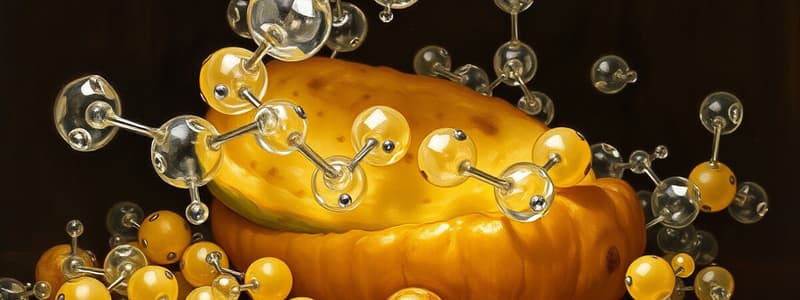Podcast
Questions and Answers
What is the chemical formula for dihydroxyacetone?
What is the chemical formula for dihydroxyacetone?
CH2OH - C = O - CH2OH
Which of the following statements is true about enantiomers?
Which of the following statements is true about enantiomers?
D-glucose and L-glucose are the same compound.
D-glucose and L-glucose are the same compound.
False
What is the classification of D-fructose?
What is the classification of D-fructose?
Signup and view all the answers
Glucose is commonly known as ___ or ___ sugar.
Glucose is commonly known as ___ or ___ sugar.
Signup and view all the answers
How is the number of optical isomers calculated?
How is the number of optical isomers calculated?
Signup and view all the answers
What is the specific rotation of a chiral compound in the context given?
What is the specific rotation of a chiral compound in the context given?
Signup and view all the answers
Fructose is less soluble than other sugars.
Fructose is less soluble than other sugars.
Signup and view all the answers
Match the following terms with their definitions:
Match the following terms with their definitions:
Signup and view all the answers
Study Notes
Carbohydrates Overview
- All carbohydrates in the human body are in the D-form, with the exception of dihydroxyacetone.
- Chemical formula for dihydroxyacetone: $CH_2OH - C = O - CH_2OH$.
- Dihydroxyacetone lacks chiral carbons.
Chiral Carbons and Enantiomers
- The position of the -OH group on the chiral carbon atom farthest from C=O determines D- or L-type configurations.
- D-glucose and L-glucose are two types of glucose.
Glucose Structures
-
D-Glucose Structure:
- CHO
- H-C-OH
- HO-C-H
- H-C-OH
- H-C-OH
- CH2OH
-
L-Glucose Structure:
- CHO
- HO-C-H
- H-C-OH
- HO-C-H
- HO-C-H
- CH2OH
Hexoses
- D-Galactose:
- Formula: $C_6H_{12}O_6$
- Structure includes multiple -OH groups.
- Glucose's structure is identical in chemical formula to other hexoses like galactose.
Optical Activity
- Compounds with chiral carbons are optically active and termed optical isomers.
- Enantiomers are stereoisomers that are non-superimposable on their mirror images, caused by chiral carbons.
D-Glucose Characteristics
- Also known as dextrose or grape sugar; found in blood and tissue fluids, classified as blood sugar.
- Normal fasting blood glucose levels: 3.9-5.5 mmol/l.
- Does not require digestion and can be administered intravenously.
Optical Isomers
- The number of optical isomers equals $2^n$, where n is the number of chiral carbons.
- Glucose requires no digestion, providing immediate energy.
Optical Activity Mechanism
- Chiral compounds rotate polarized light: clockwise (+) or counter-clockwise (-).
- Specific rotation example: 30°.
D-Fructose
- Formula: $C_6H_{12}O_6$.
- Structure includes diverse functional groups.
- Classified as a ketohexose with 8 optical isomers.
- Commonly referred to as levulose or fruit sugar; naturally found in fruits and honey.
- Fructose is the sweetest and most soluble sugar, often used as a dietary sugar.
Monosaccharide Structures
- Monosaccharides with five or more carbon atoms exist in equilibrium between open-chain and cyclic forms, with cyclic structures being predominant.
- Haworth projections represent the ring structure of monosaccharides.
Studying That Suits You
Use AI to generate personalized quizzes and flashcards to suit your learning preferences.
Description
This quiz covers the essential details regarding carbohydrates in the human body, focusing specifically on dihydroxyacetone and the classifications of D- and L-glucose. Participants will explore the structural characteristics and chemical formulas associated with these carbohydrates, enhancing their understanding of carbohydrate chemistry.




